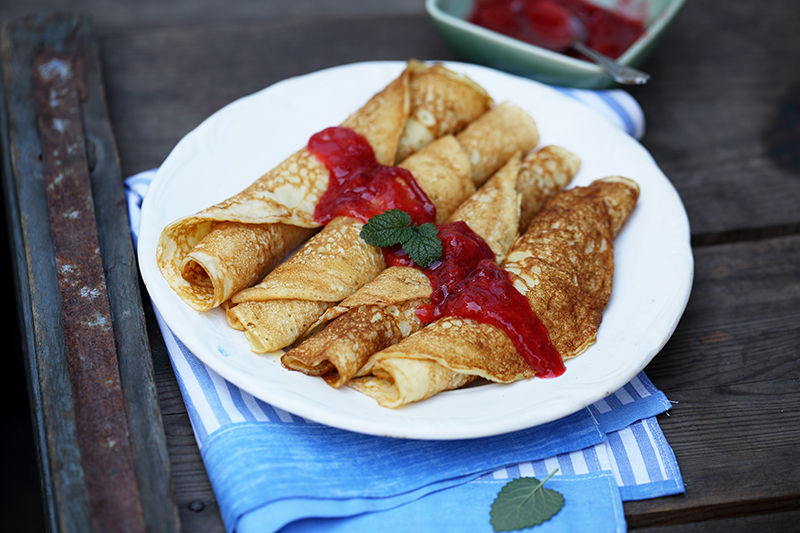In France, the three days preceding Ash Wednesday are called Carnivale (literally: “Farewell Meat”), ending with Mardi Gras (“Fat Tuesday”). Among the people of the British Isles, the period is referred to as Shrovetide, “shrove” being the past tense of “shrive” (which means to go to Confession, obtain absolution and perform the penance).
While Carnivale has morphed into a festival of riotous merrymaking before Lent, Shrovetide is more simply marked by cleaning homes, running races — and eating pancakes.
Both events began more than 1,000 years ago as Catholics rid their homes of meat and animal byproducts (such as eggs, butter, milk, cheese and lard) before meatless, fasting days. That’s when Lent was more stringently observed.
Shrovetide is comprised of Shrove Sunday, when people go to Confession before or after Mass, Collop Monday and Shrove Tuesday.
A collop is a slice of meat, traditionally a slice of cured meat (such as bacon or salt pork). Collops were eaten to use up the last of the cured meats that were not expected to last until Easter (prior to modern refrigeration). The pork drippings were used for pancakes eaten on Shrove Tuesday, the last chance to confess before Ash Wednesday.
In England on Shrove Tuesday many localities sponsor a “pancake race,” a tradition said to have begun in Olney in 1445. According to legend, when the church bells rang for Confession, one woman, engrossed in making pancakes, ran to church, still clad in her apron, skillet in hand. Today, runners must carry skillets, flipping a pancake as they run.
My parents made flavorful pancakes. My sister Helen, my brothers Sandy and Bill, and I all looked forward to Sunday pancake breakfasts. Allow me to share the Wright family recipe.
Shrove Tuesday Pancakes
> 2 eggs
> 2 cups flour
> 3/4 — 1 teaspoon salt
> 2 teaspoons baking powder
> 1 quart buttermilk (or sour milk)
> 1/2 — 3/4 cup water
> Link sausages or sausage patties (enough to provide 3 or 4 tablespoons of sausage drippings)
Recipe Notes:
English pancakes are thinner than the American version, but not as thin as French crepes. Also, there is a difference between sour milk and milk that has gone bad. Sour milk has an agreeably tangy aroma. A strong, unpleasant odor indicates milk you don’t want to use. If you don’t trust your nose, stick with buttermilk.
Cooking Instructions:
In a mixing bowl beat the eggs before adding the milk. My father liked to put a smidge of water into the milk carton, shake it, then pour it into the bowl. He claimed the water helped crisp the pancakes’ edges.
Place flour, salt and baking powder in a sifter and sift into the milk and eggs. Thoroughly whisk the mixture for a couple of minutes until the flour is thoroughly incorporated then let rest. Cook the sausage. Spoon the drippings into the batter and stir well.
My father deglazed the skillet with water after the sausages were removed. This was served in a little pressed-glass pitcher to pour over the pancakes. He called it “pan-washing gravy.” He also insisted on melting a cube of butter, served in a similar pitcher with a spoon. Mom disparaged the practice as “drunken sailor extravagance,” but Papa always won the day.
Now, lightly grease a griddle or a large skillet. My parents had a heavy aluminum Guardian Service griddle which never needed greasing. They are no longer manufactured, but keep an eye out for them in an antique store or on eBay. They’re well worth having.
The griddle is ready when a drop of water dances on the surface. Adjust the flame to maintain an even heat and spoon the batter onto the griddle. My parents always made a test pancake just to be sure.
Papa preferred making silver dollar-sized pancakes, two to three inches in diameter. Mom’s pancakes were slightly larger, five to six inches across. Both sizes cook more quickly and are easier to turn than larger pancakes, but let your conscience be your guide. Some folks like pancakes as big as the pan.
Surface bubbles will form. When the bubbles cease, turn the pancakes. Let them cook for a shade less than a minute. You can also roll a few pancakes around the sausages to have pigs-in-blankets. And, to really do it up right, poach some eggs to place on top of the pancakes.
Make a few batches and set the platter of pancakes in a warm oven until you’re ready to call your family together to eat your Shrove Tuesday pancakes.
As a child, seeing the butter and egg yolks dripping down the stacks, with the pigs-in-blankets to the side, I recall thinking, “Kings don’t eat as well.” I still believe it.

